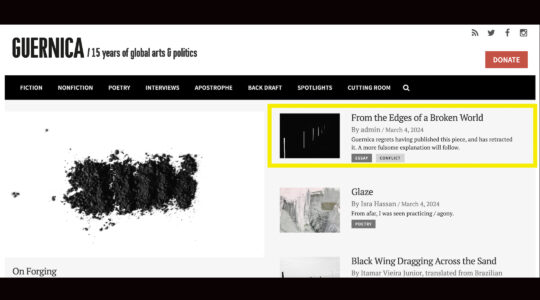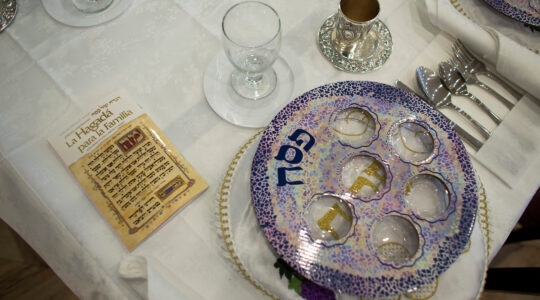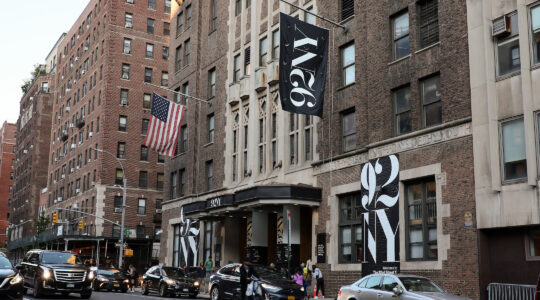Back in May, the Chicago Sun-Times had a short write-up hailing “Imaginary Coordinates,” a multimedia exhibit at the Spertus Museum that “juxtaposes the [institution’s] collection of antique maps of the Holy Land against contemporary artworks by Israeli- and Palestinian-born women artists riffing on what you might call cartographic themes: national identity, cultural boundaries, place and displacement.”
According to the paper, the exhibit suggested a willingness by Spertus officials to “re-energize, if not radicalize, its programming in ways that may not be what many visitors expect from a Jewish institution.” For example, several of the works “implicitly criticize” Israeli treatment of the Palestinians.
What some might view as artifacts of Israeli triumphalism – a 1970 Hanukkah lamp studded with bullet casings, a recent official publication extolling the security wall’s effectiveness in reducing terrorist attacks – bounce off homey folk embroidery by Palestinian women.
Then there are several works by female Israeli artists that are no less politically fraught. The most harrowing of these is Sigalit Landau’s “Barbed Hula” (2001), a video loop in which the artist, stark naked on a beach in Tel Aviv, shimmies inside a hula hoop made of barbed wire. The barbs on the hoop, like those on the razor wire atop a certain wall, point outward. But the growing welts on the artist’s skin are dire enough to make her point about the collateral, self-inflicted wounds that can result from the pursuit of security.
To hammer home the point, the paper cited a catalog essay, by Rhoda Rosen, the director of the museum, in which she said that Spertus is moving “from the parochial toward the civic,” adding that “while the new Spertus’ starting point continues to be Jewish experience, the institution does not operate from a partisan point of view.” There will be times, she added, that “broadly accepted Jewish assumptions will be examined and cherished, and at others they will be examined and questioned.”
All this under the headline: “In ‘Imaginary Coordinates,’ Spertus maps its independence.”
As it turns out, it wasn’t the coordinates that were imaginary.
The Chicago Tribune published a front-page story on Saturday announcing that, in the face of anger from Jewish supporters, the museum had pulled the plug on the exhibit.
Under intense pressure from angry Jewish patrons, the Spertus Institute of Jewish Studies on Friday abruptly closed the controversial “Imaginary Coordinates” exhibition, which explored Israeli and Palestinian concepts of homeland and how that is defined both historically and in the present day.
Critics charged that the combination of historical Holy Land maps and contemporary artwork cast Israel in a negative light.
“Aspects of it were clearly anti-Israel,” said Steven Nasatir, president of the Jewish United Fund/Jewish Federation of Metropolitan Chicago. “I was very surprised that a Jewish institution would put forward this exhibition. I was surprised and saddened by it.”
As for the museum’s president:
Spertus President Howard Sulkin expressed regret that the exhibition caused pain for its core constituents. But he said the concept behind it fit with the evolving mission of the museum.
“A willingness to experiment is incorporated right into our core principles, and we see one of our roles as being a place that inspires dialogue on the critical issues of our time,” Sulkin said Friday.
On Tuesday the Tribune published an opinion piece by Patty Gerstenblith, a professor at the DePaul University College of Law and director of the Center for Art, Museum and Cultural Heritage Law, criticizing the museum’s decision. She lamented that sometimes “donors wield more influence over museum exhibits than the museum’s professional staff and that controversial topics cannot be raised because of objections from a local community.”
Her conclusion:
The Chicago community and its Jewish community, in particular, have been denied an opportunity to explore the mental state that underlies the conflicts of the Middle East, while the vital role of museums as independent entities has been undermined.
P.S. The exhibit might be closed, but – as of Tuesday morning – the initial news item praising the exhibit and the museum’s independent streak is still posted on the museum’s Web site.





